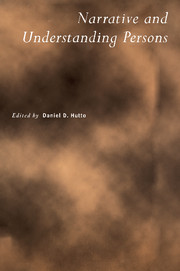Book contents
- Frontmatter
- Contents
- List of Contributors
- Notes on Contributors
- Narrative and Understanding Persons
- Framing Narratives
- The Narrative Practice Hypothesis: Origins and Applications of Folk Psychology
- Dramatic Irony, Narrative, and the External Perspective
- Episodic Ethics
- On the Distance between Literary Narratives and Real-Life Narratives
- Reasons to be Fearful: Strawson, Death and Narrative
- Stories, Lives, and Basic Survival: A Refinement and Defense of the Narrative View
- Self and Other: The Limits of Narrative Understanding
- Pathologies in Narrative Structures
On the Distance between Literary Narratives and Real-Life Narratives
Published online by Cambridge University Press: 04 May 2010
- Frontmatter
- Contents
- List of Contributors
- Notes on Contributors
- Narrative and Understanding Persons
- Framing Narratives
- The Narrative Practice Hypothesis: Origins and Applications of Folk Psychology
- Dramatic Irony, Narrative, and the External Perspective
- Episodic Ethics
- On the Distance between Literary Narratives and Real-Life Narratives
- Reasons to be Fearful: Strawson, Death and Narrative
- Stories, Lives, and Basic Survival: A Refinement and Defense of the Narrative View
- Self and Other: The Limits of Narrative Understanding
- Pathologies in Narrative Structures
Summary
It is a truth universally acknowledged that great works of literature have an impact on people's lives. Well known literary characters—Oedipus, Hamlet, Faustus, Don Quixote—acquire iconic or mythic status and their stories, in more or less detail, are revered and recalled often in contexts far beyond the strictly literary. At the level of national literatures, familiar characters and plots are assimilated into a wider cultural consciousness and help define national stereotypes and norms of behaviour. In the English speaking world, Shakespeare's plays or the novels of Jane Austen, the Bronte sisters, Dickens, and Trollope, provide imaginative material that reverberates in people's lives every bit as much as do the great historical figures, like Julius Caesar, Elizabeth I, Horatio Nelson, or Winston Churchill. What is striking is how often fictional characters from the literary tradition—like the well-loved Elizabeth Bennett, Jane Eyre, Oliver Twist, Pip, Tess of the d'Ubervilles—enter readers' lives at a highly personal level. They become, as Martha Nussbaum puts it, our ‘friends’, and for many readers the lives of these characters become closely entwined with their own. Happy and unhappy incidents in the fictional worlds are held up against similar incidents in the real lives of readers and such readers take inspiration from the courage, ingenuity, or good fortune of their fictional heroines and heroes. Nowhere is it more true that life imitates art.
- Type
- Chapter
- Information
- Narrative and Understanding Persons , pp. 117 - 132Publisher: Cambridge University PressPrint publication year: 2007
- 13
- Cited by



